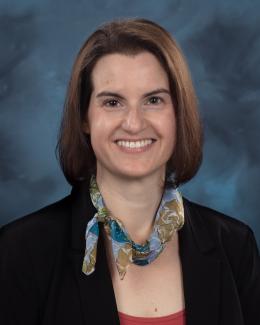September 22, 2016 – Melissa Allen, a researcher at the Department of Energy's Oak Ridge National Laboratory, is guided by her curiosity and is inspired to pursue what she loves – music, flying and climate science. And she credits her family and many mentors who have helped her along the way.
Growing up in Colorado, she was intrigued by her father Dan McGuire, a retired ORNL physicist who formerly worked at the Rocky Flats nuclear weapons production facility near Denver.
“I knew he was a scientist, so I tried to ask him questions about science. He always answered clearly and in a way a kid could understand,” said Allen, who is a post-doc in CCSD’s Critical Infrastructure and Climate Change team within the Geographical Information Science and Technology group.
Her work is focused on urban infrastructure and atmospheric transport, creating models to determine the effects of temperature and climate changes on human activity. She has co-authored papers appearing in Nature Energy, Journal of Geophysical Research, Journal of Geography and Natural Disasters and Sustainability.
But her path to a PhD in energy science and engineering began with the violin.
Not only had her dad introduced Allen to science, but he also exposed her to classical stringed instruments. She recalled as a young girl watching him build violins and re-hair violin bows for a neighbor. He also developed a new varnish designed to enhance the violin’s sound quality.
Allen immersed herself in learning to play violin and viola. As she honed her craft, she went on to receive her bachelor’s degree in music education from the University of Northern Colorado, played as an orchestral violinist and taught orchestra and choir on the middle school and high school levels.
Her successful career as a performer and educator took a fateful turn while on her honeymoon with the late John Allen, who worked as a computational scientist at ORNL.
“We had gone to the Outer Banks and ended up going to Kitty Hawk. We had a great time flying in a Waco biplane over the ocean, wearing scarves, hats and goggles,” she remembered. “I just fell in love with it.” John and his grown children (who had flying experience) encouraged Allen to obtain her private pilot’s license.
Again, Allen’s curiosity was piqued.
As a self-described tactile, visceral learner, flying connected her with the atmosphere. Feeling changes in temperature and watching ice crystals form on the wing intrigued her to learn more.
“Flying made studying climate science more real,” Allen said. “I was able to tie my physical experience back to the classroom.”
In 2014, she completed her doctorate in energy science and engineering through the University of Tennessee-ORNL Bredesen Center for Interdisciplinary Research and Graduate Education and was among the program’s first graduating class.
She connected with several mentors who motivated and encouraged her, including the late David Erickson, Steven Fernandez (retired), Joshua Fu and Dr. Lee Reidinger, Bredesen Center director.
“When I first made the music into science transition, I wanted to focus on atmospheric transport and air circulation,” Allen said. For her first published paper under Erickson’s lead, titled, “The influence of internal model variability in GEOS-5 on interhemispheric CO2,” she investigated the ability of the GEOS-5 model to capture the annual CO2 cycle at different places on the globe, and how to explain the differences between the model and observations at key locations in the southern hemisphere.
Her research has since evolved and now includes running a variety of different models from climate to infrastructure and integrating results to answer questions important to human adaptation to future global change.
“The best things about working at ORNL are world-class scientists and access to a world-class computing facility,” she said. “The computing facility wouldn’t be enough without the people and their knowledge.”
While building her new career at ORNL, she still finds time for her first loves – music and flying. Allen currently plays in string quartet, and she has kept her pilot’s license current and intends to get back into the air soon.
ORNL is managed by UT-Battelle for the Department of Energy's Office of Science, the single largest supporter of basic research in the physical sciences in the United States. DOE’s Office of Science is working to address some of the most pressing challenges of our time. For more information, please visit energy.gov/science.





